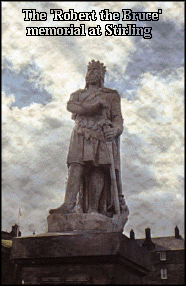


The King of England, Edward 'Longshanks' I, had had enough and
made his way to Scotland with a powerful army to defeat Wallace and his
men in the town of Falkirk in 1298. This is where we'll bring in  Robert
the Bruce. At one time Robert stood next to Wallace proclaiming to the
people that he, as royalty, would stand with them in battle to fight for
his country. He later changed his mind and decided that the odds were with
the English, and so joined ranks with them.
Robert
the Bruce. At one time Robert stood next to Wallace proclaiming to the
people that he, as royalty, would stand with them in battle to fight for
his country. He later changed his mind and decided that the odds were with
the English, and so joined ranks with them.
Wallace, after being defeated, made for foreign lands to try and gain support for his cause, but on his return to Scotland in 1305, he was captured by the governing English in Glasgow and was taken to London. Convicted as a criminal of the state he was sentenced to death and promptly hung by the neck. As if that weren't bad enough, whilst still alive he was disemboweled, his head cut off and his body cut into quarters. Robert watched while Wallace's head was displayed high on London Bridge and the four quarters of his body taken to Newcastle, Berwick, Perth and Stirling for display there.
Edward I had to wonder if he had done the right thing, or had he created his worst nightmare - a Martyr that the Scots could cherish forever!

It wasn't until 1304 that he began to show signs of where his heart was, and he made a treaty with the kirk (the church) that would help his attempt at the throne of Scotland. Robert the Bruce new that with religion behind him he was more likely to win the support of the people. Time passed and by the end of 1305 he was a natural leader and made his plans for the throne of Scotland clearer. A meeting with John the red Comyn at Greyfriars church in Dumfries marked the last obstacle in his path, and during the argument they were having Robert stabbed John to death. Ceasing his chance he then moved on to Scone where he claimed the throne and was crowned King Robert I of Scotland, and was given the traditional blessing from Countess Isabel of the MacDuffs.
On becoming King, the Scottish people gathered around their new king and looked to him now for their freedom. After a number of battles, some successful and others not, it is at this point that the legend of Robert the Bruce is best known. After a bloody defeat, and whilst taking refuge in a dark cave escaping the English army, Robert sat and pondered his campaign. Feeling the power of failure he looked up and saw a small spider climbing up its silken thread to reach its web, time and time again the spider fell, but returned again to struggle its way home. As you might have guessed, the influence that this imagery had on Robert lead him to pick up his sword and exclaim "If at first you don't succeed - try, try again!". His words remain with us all still.
And that is indeed what he went out and did.

Robert the Bruce was now marking himself in history as a hero to his people. But he hadn't finished there. The victory at Bannockburn did not end the fighting, but it cast rumours amongst the opposing English that an army of half the size of Edwards had won - it gave Bruce the upper hand. Finally the wars were over and he had managed to achieve what was thought impossible - freedom for Scotland. The Edinburgh-Northampton treaty was formed and signed in 1328 giving King Robert the Bruce his greatest victory - complete rule of Scotland as an independent country, with no subjections.
Now known throughout the land as 'Good King Robert' he further made a treaty with the Pope known as the 'Declaration of Arbroath' and this still stands as the most remarkable statement of nationalism in medieval history. The support of the Pope to the Scottish cause. For a while King Robert I named his brother Edward as heir, but he was killed (1318) in Ireland trying to claim the Irish throne before he could claim the title. the succesion was handed to the family of Robert's daughter, Marjory, who had married Walter Steward. However in 1324 the king finally fathered a legitimate son, the future David II.
Now at peace with England, reconciled by the Pope, master of an ordered realm and with the succession now secured, on June 7th 1329 Robert the Bruce of Scotland died of leprosy and his heart was cut out and taken on a crusade as a final gesture to God that he wanted to atone for the sins of his youth. He didn't need forgiveness from Scotland - they had forgiven him a long time before.
So Robert the Bruce - King of Scotland had achieved the dreams of Wallace. Although Wallace is still the true patriot who never once wandered from his devotion to his homeland, Robert the Bruce - after some wandering and indecision about his loyalty, was the one who gained Scotland its freedom. As to who is the 'Braveheart', I know who I would stand by, its up to you to make your own mind up!

It is a romantic thought that the Bruce's campaign was the asking of forgiveness for the betrail he bestowed on Wallace some years before, and it may be nice to think that they have long since made their peace - but would they approve of the Scotland of today?
 Copyright 1995/96 Catalyst (Highlands) Ltd. Highlander
Web Magazine.
Copyright 1995/96 Catalyst (Highlands) Ltd. Highlander
Web Magazine.
Pages by Webspinner
admin@catalyst-highlands.co.uk